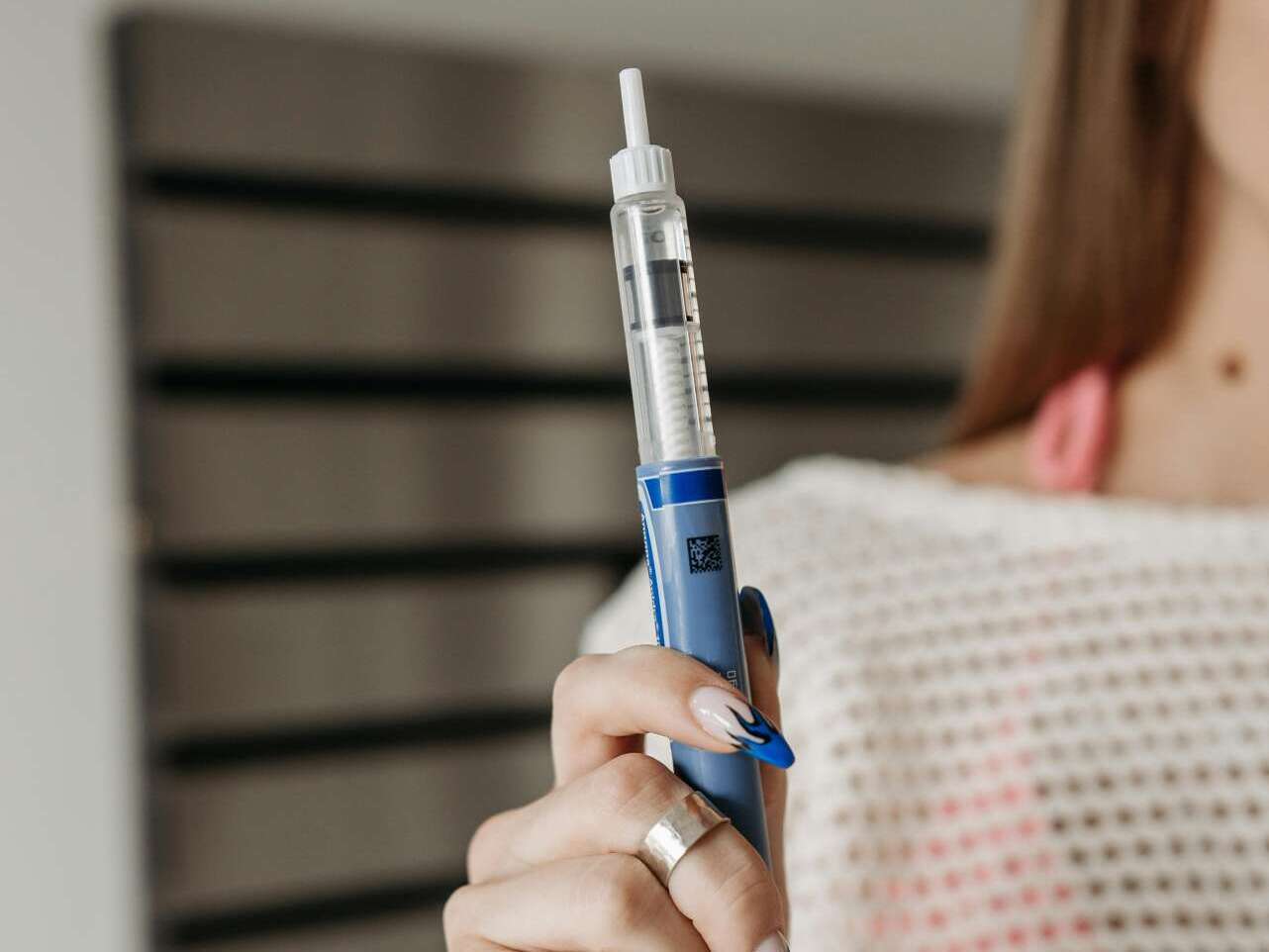
Ozempic is a unique medicine primarily used by adults with Type 2 Diabetes. This condition prevents the body from using insulin properly, which can lead to high blood sugar levels if left untreated. Ozempic functions as the body’s helper by helping to keep blood sugar levels normal.
Ozempic contains semaglutide as its active ingredient. Unlike conventional pills, it is administered through subcutaneous injections – a specialized shot under the skin – usually in the abdomen or thigh area.
Here’s Why Adults Might Turn to Ozempic
- Ozempic aims to help combat cardiovascular disease. In other words, It may help to keep your heart healthy. Therefore, it is might be particularly beneficial to those with heart problems and diabetes. Watch this area as more data comes out.
- Ozempic also helps control your blood sugar levels. This is especially important because too much sugar often isn’t good for the body.
An unexpected discovery: Ozempic and weight loss
But wait, there’s more! Though initially developed to treat adults with Type 2 Diabetes, healthcare professionals noticed significant weight loss in those taking Ozempic. This unexpected outcome sparked further investigation, leading to controlled studies focusing on Ozempic’s weight management properties.
These studies revealed that semaglutide, the active component in Ozempic, not only helps regulate blood sugar levels, but also suppresses appetite, and makes you feel full for longer. This research has led to doctors giving their patients Ozempic for another reason – to help people lose weight.

What You Need to Know About Ozempic
Let’s delve into the important stuff about Ozempic:
- Semaglutide is the main ingredient that makes Ozempic work. It mimics a hormone in your body that you make naturally.
- Ozempic is a branded medicine, so you can’t find it as a generic (a cheaper alternative).
How Ozempic works to regulate your blood sugar levels
If you’re curious about how Ozempic works, here’s a simple breakdown:
- After eating, Ozempic helps the body make more insulin, a naturally occurring hormone that helps keep blood sugar levels just right.
- It also tries to slow the speed at which food moves through your stomach. This slower rate of digestion ensures that sugar doesn’t rush into the blood as quickly.
- Finally, Ozempic helps to reduce the amount of sugar that gets into the blood from food.
Research into Ozempic
Clinical trials have shown that Ozempic’s active ingredient, a glucagon-like peptide-1 (GLP-1) receptor agonist, can significantly reduce the risk of adverse cardiovascular events in adults with Type 2 Diabetes. Ozempic contains the same active ingredient as other medications approved for different uses, highlighting its versatility in medical treatment.
Developed by Novo Nordisk, Ozempic is prescribed to improve blood sugar control and has also been noted for its effectiveness in reducing body weight. It is administered through weekly injections, which are generally well-tolerated, although some users may experience side effects such as stomach pain. As this is a new drug, we are still trying to research the long-term effects and side effects more.
As a GLP-1 receptor agonist, Ozempic enhances insulin secretion and lowers glucagon secretion, making it a popular choice for healthcare providers to prescribe the drug for adults with Type 2 Diabetes management.
Side Effects of Ozempic

Like any medication, Ozempic may have specific side effects. The most common side effects till now by those taking Ozempic are:
- Nausea
- Vomiting
- Diarrhoea
- Abdominal discomfort
In rare cases, Ozempic can cause mild allergic reactions to severe allergic reactions. Seek medical help immediately if symptoms of an allergic reaction occur.
In addition, Ozempic may cause some to experience a decrease in appetite. Whilst this can contribute to weight loss, it may also lead to a person not taking in enough calories if it is not managed correctly.
Ozempic may cause serious side effects, including cancer, e.g. thyroid, so more research is being done, and the doctor will assess your suitability.
Initial fatigue caused by Ozempic
Experiencing initial fatigue is a common occurrence for individuals starting on Ozempic. This fatigue typically arises as the body adjusts to the medication and its effects on blood sugar regulation and metabolism. As Ozempic works to improve insulin sensitivity and lower blood sugar levels, it may initially cause fluctuations in energy levels as the body adapts to these changes.
How long does Ozempic fatigue last?
The duration of fatigue, a side effect of Ozempic, varies among individuals. It typically resolves within a few days to a few weeks after first starting treatment.
If fatigue persists or significantly impacts daily activities, it is essential to consult a healthcare provider to assess and potentially adjust your treatment plan and rule out other causes.
How to treat diarrhea caused by Ozempic
If you experience diarrhea while taking Ozempic, it’s crucial to maintain hydration and electrolyte balance. Over-the-counter remedies may relieve the problem, but it is essential to consult a healthcare professional who can offer specific advice or adjustments to your Ozempic regimen.
Dietary modifications, such as avoiding foods that exacerbate diarrhea, can also be beneficial in managing this side effect.
Relieving nausea caused by Ozempic
Ozempic-induced nausea can often be relieved by starting with a low dose and gradually increasing it over time. Eating smaller, more frequent meals and avoiding foods high in fat or with strong odors can also help reduce nausea.
If severe nausea persists, it is essential to consult a healthcare provider to assess and potentially adjust your treatment plan.
Can Ozempic cause joint pain?

Some individuals on Ozempic may experience joint pain as a side effect, although it is not one of the most common. If you experience severe joint pain, it is advisable to consult your healthcare provider.
How Ozempic and cancer may be linked
The United States Food and Drug Administration (FDA), which ensures that medicines are safe, has warned about Ozempic. They have shared that in some animal studies, Ozempic was linked to Thyroid Cancer. We’re not sure if it can happen to humans, but it is something to be aware of.
As a precautionary measure, people who already have a specific type of Thyroid Cancer or a condition called Multiple Endocrine Neoplasia Syndrome Type 2 should not take Ozempic.
Does Ozempic cause trouble swallowing?
Those taking Ozempic should be aware of the potential risk of thyroid tumours. It is important to promptly inform a healthcare professional if you notice any unusual symptoms such as a lump or swelling in your neck, hoarseness, trouble swallowing, or shortness of breath, as these could be indicators of a thyroid tumor.
Studies conducted with rodents have shown that Ozempic and other prescription drugs with similar mechanisms of action can lead to the development of thyroid tumors, including cancer. While researchers need to further study the exact risk in humans, it’s crucial for individuals using Ozempic to remain vigilant and report any concerning symptoms to a healthcare professional for evaluation and appropriate management.
What to do if you’re experiencing side effects of Ozempic
Just like any other prescription medication, you need to report any bad reactions you experience as soon as possible. Regular monitoring and open communication with a healthcare professional you trust can help you mitigate the risks and ensure the safest and most effective use of Ozempic.
How to Administer an Ozempic Injection

Using Ozempic correctly is crucial for its effectiveness. Here is a guide on administering Ozempic injections in your thigh to get the most out of your treatment.
- First, clean the injection site (your thigh) with an alcohol swab.
- Then use a pinch-up technique to create a fold of skin at the injection site.
- Insert the needle at a 90-degree angle into the pinched-up skin.
- Press the plunger to deliver the dose.
- Release the skin fold before removing the needle.
If you are still unsure of how to administer the medication correctly, it is best to ask a healthcare professional for a demonstration or any additional assistance.
How Long Does it Take for Ozempic to Impact Your Weight?
The timeline for weight loss while taking Ozempic can vary significantly from person to person, depending on various factors such as:
- starting weight
- diet
- exercise habits
- individual metabolic rates
Clinical trials have shown that individuals using Ozempic can achieve significant weight loss within a few months of starting treatment, with many experiencing noticeable results within the first three to six months. However, the rate of weight loss may slow down over time as the body adjusts to the medication. Some individuals may continue to see gradual weight loss over several months, while others may reach a plateau.
It’s important to remember that sustainable weight loss by taking Ozempic alone. It often requires a long-term commitment to healthy lifestyle habits, including dietary changes, regular physical activity, and medication.
Therefore, while Ozempic can be a valuable tool for weight management, the timeline for achieving weight loss goals may vary and require ongoing dedication and patience.
Maintaining a Healthy Diet on Ozempic

Maintaining a nutritious diet alongside Ozempic treatment is crucial for maximizing its effectiveness and ensuring overall health and well-being. While Ozempic can help you control your weight and blood sugar levels, it works best with healthy lifestyle choices, particularly dietary habits. Here are a few tips.
Balanced meals
Focus on a diet rich in vegetables, lean proteins, and whole grains to manage appetite and blood sugar levels while on Ozempic. Since Ozempic affects blood glucose levels, incorporating low-carb foods can help maintain stable glucose levels.
Small, frequent meals
Eating smaller meals more frequently can help mitigate potential gastrointestinal side effects like nausea associated with Ozempic.
Hydration
Adequate water intake is essential, as Ozempic can sometimes cause dehydration, especially if you experience side effects like nausea or diarrhea.
Limited sugary and fatty foods
Reducing high-sugar and high-fat food intake can enhance Ozempic’s effectiveness in weight loss and blood sugar control.
Controlled coffee intake
In general, you can consume Ozempic and coffee together. However, monitoring your body’s response to your coffee intake is essential as caffeine can sometimes exacerbate specific side effects of Ozempic, like nausea or jitteriness.
Does Ozempic Need to be Refrigerated?
Yes, Ozempic does need to be refrigerated. You should store your Ozempic at 2°C to 8°C (36°F to 46°F) before opening. Once opened, it can be kept at room temperature (below 30°C/86°F) or in the refrigerator and should be used or discarded within 56 days [check the box]. Remember to keep Ozempic away from direct heat and light, and do not freeze it.
What to do if you’ve forgotten your Ozempic out overnight
Accidents happen. If you’ve left your Ozempic out overnight, it is essential to check the temperature of the room it was left in. Ozempic can be stored at room temperature (up to 30°C/86°F) for a short period. Still, its effectiveness might be compromised if the temperature is higher or out for an extended period.
What to do in the case of a missed dose of Ozempic
If you miss a dose of Ozempic, take it as soon as you remember unless it’s close to the time for your next dose. In that case, skip the missed dose and proceed with your regular dosing schedule. Do not take an extra dose to make up for the missed dose.
Can You Drink Alcohol on Ozempic?
In general, moderate alcohol consumption is generally acceptable. However, it is essential to approach alcohol intake with caution while taking Ozempic.
Alcohol can affect blood sugar levels and may interact with medications, including Ozempic. Consuming alcohol in excess or on an empty stomach can potentially lead to fluctuations in blood sugar levels, increasing the risk of hypoglycaemia (low blood sugar) or hyperglycaemia (high blood sugar).
Alcohol can also add empty calories to your diet and may hinder weight management efforts. Therefore, if you choose to drink alcohol while on Ozempic, it is essential to do so in moderation and with careful consideration.
Can You Take Ozempic While Breastfeeding?

The safety of using Ozempic while breastfeeding is not well-established. Clinical data on the effects of Ozempic on breast milk and nursing infants is limited.
Healthcare providers often advise against the use of Ozempic during breastfeeding due to potential risks and the lack of comprehensive safety information. If it is necessary for you to take Ozempic, you should discuss the benefits and potential risks with a healthcare professional and alternative feeding options for the infant, other than breast milk, may need to be planned.
Ozempic’s Interactions With Other Prescription Drugs
You should always be aware of drug interactions. Taking Ozempic alongside certain vaccines, foods, or other medications can influence its effectiveness. It is, therefore, essential to inform your doctor about all the medications you’re taking, both prescription and over-the-counter, before starting treatment on Ozempic.
Some drugs, herbs, or supplements you shouldn’t use with Ozempic include:
- Other GLP-1 agonists like Ozempic (e.g., Saxenda).
- Additional weight loss products, including Orlistat (Alli, Xenical) and green tea.
- Other drugs, including diabetes medications like insulin and glipizide (Glucotrol XL).
What Happens if You Take Too Much Ozempic
If you take too much Ozempic, you may experience severe side effects like extreme nausea, vomiting, or hypoglycaemia. If you do take more than your recommended dose, it is crucial to seek immediate medical attention.
How To Know When Your Ozempic Pen is Empty
You can tell when Ozempic pens are empty when the dose counter reaches ‘0’, indicating that all the medication has been used. Another way to tell is if you cannot set your prescribed dose on the pen.
How Ozempic compares to Saxenda
When browsing media articles about Ozempic, web results will often mention another prescription drug, Saxenda. Here’s how Ozempic and Saxenda compare.
What is Saxenda?
Saxenda is a brand-name medication that contains the active ingredient liraglutide. It is an injectable prescription medication used for weight management in adults who are overweight or obese, particularly those with weight-related medical problems.
How does Saxenda work?
Saxenda mimics the action of a hormone called glucagon-like peptide-1 (GLP-1), which helps regulate appetite, food intake, and body weight. It is typically prescribed as part of a comprehensive weight loss program that includes a reduced-calorie diet and increased physical activity. It is effective in helping individuals achieve and sustain weight loss when used as directed under the supervision of a healthcare provider.
How does Ozempic compare to Saxenda?
Both Ozempic and Saxenda have demonstrated effectiveness in aiding weight loss, but they work through slightly different mechanisms. At first, it might seem like the critical contrast between Saxenda and Ozempic is their injection frequency. Saxenda requires a daily jab, whilst Ozempic only requires one once a week.
But here’s the real deal: the FDA has officially approved Saxenda as a weight loss medication in the UK. The crucial difference lies right there. Unlike Saxenda, the FDA has not approved Ozempic for weight management and is often prescribed off-label.
So the question is, should you purchase Ozempic or Saxenda? Ultimately, the choice between Ozempic and Saxenda depends on individual preferences, cost considerations, and your specific health needs.
It is important to discuss your options with your healthcare provider to determine which medication may be the most suitable for you.
Key Takeaways
- Ozempic was initially developed to manage Type 2 Diabetes but was later found to be beneficial for weight management. Ozempic works by mimicking the action of a hormone called glucagon-like peptide-1 (GLP-1), which helps regulate blood sugar levels and suppresses appetite.
- Saxenda, on the other hand, was specifically developed for weight management and works similarly by mimicking GLP-1 to reduce appetite and increase feelings of fullness.
- The distinction between Saxenda and Ozempic is clear. Saxenda is FDA approved for weight management, whilst Ozempic is not.
However, your choice depends on your specific needs, so contact your healthcare provider for personalised guidance.
Want to purchase Ozempic?
Watch my video guide down below or here before you decide if you’d like to start Ozempic treatment.

